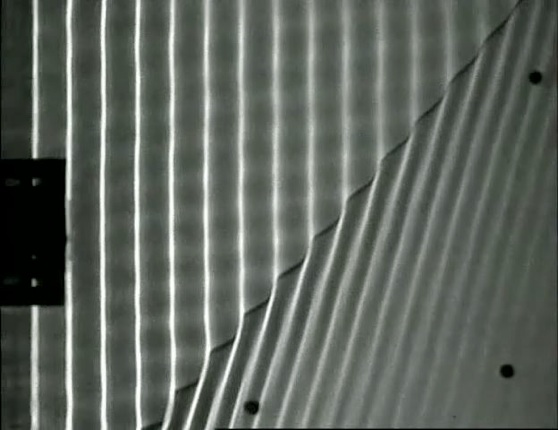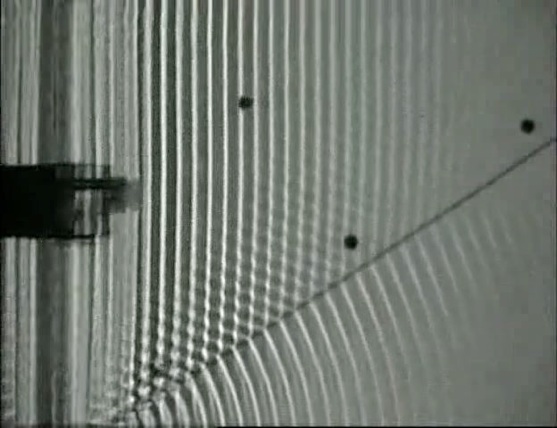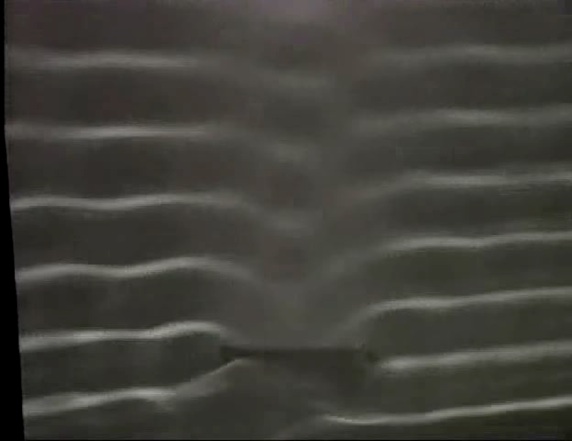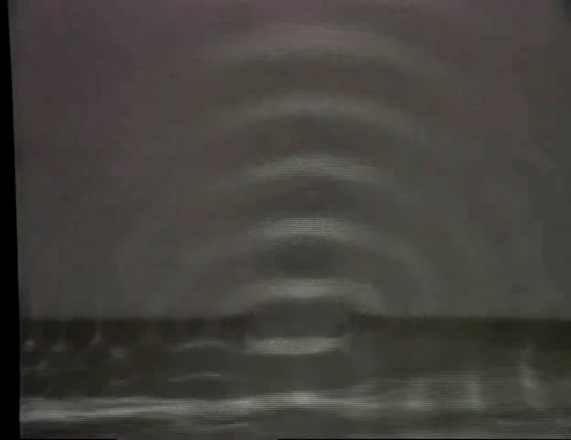Physics Essay 2.1 updated Fall, 2011
Waves in Water
What Properties do Waves Possess?
Is Light a Wave or a Particle?
In class, you observed waves moving along the surface of a shallow tank of water. You have some direct experience with these types of waves from swimming in the ocean, but some properties of water waves are not always noticed while swimming.
First, what happens to a wave as it hits a barrier, like a wall? Click here (EWS) and here (EWS) to view experiments similar to the ones we did in class. When a wave hits a barrier in the water tank, it reflects off the wall, which is similar to what we observed light do when it struck a boundary, like a mirror or a prism. What is more, the water waves, as shown in the demonstration, can be seen to reflect off of a boundary at an angle equal to the incident angle, which again, is the same result we observed for light. In other words, when a water wave approaches a boundary it has a certain incident angle with the normal (as show in the picture, Figure 1a). As the reflected wave leaves the boundary, it does so at an equal angle to the normal line as the incident angle. Again, this is just how we saw light behave in our prism experiments, although objects (or particles) also seem to reflect off surfaces at equal angles, as shown below in Figure 1b.
Figure 1a, Water waves reflect off a barrier (wall). Notice the incident angle and reflected angle are equal.

As we have seen in class, light diffracts in a similar fashion to water waves. Watch a demonstration here (EWS).
The next question is do objects (or particles) diffract in a similar way as waves? We answered this questions in class when we threw tennis ball through an opening in a wall (the class room door). So based on these experiments it seems the particle we observed do not diffract, but the waves we observed do diffract.
There are three important behaviors of water waves we have observed:
(1) Reflection: Reflection in water waves is similar to the behavior we saw with light rays, but also similar to the way particles (like racquet balls) behave. Click here (EWS) to see another way that water waves and light are similar.
(2) Refraction: Refraction in water waves is again similar to the behavior we saw with light rays, but also similar to the behavior of objects when they change speed moving onto a different surface (car video).
(3) Diffraction: We see diffraction in water waves (tank experiments) and diffraction in light (laser and razor blade experiment), but we do not see diffraction of particles (objects). We performed an experiment with tennis balls traveling through an opening in a barrier (class room door), but the tennis balls did not spread-out behind the barrier. This last behavior is an especially important one as it suggests that light is a wave, rather than a particle!
When we used a wave tank in class, you also observed waves move from an area of deep water into a more shallow area of water. This was accomplished by placing a piece of plastic in the bottom of part of the water tank to make that region more shallow. What happens to the waves as they pass from deep to shallow water? Click here (EWS) and here (EWS) to see experiments similar to those from class.
As you observed in class, and in the demo videos, the waves slow down when they enter a more shallow region of water. As the waves slow down they lag behind the part of the wave that is still traveling in the deeper region, and this causes the wavefront to bend. The ‘bending’ point is right at the boundary between the deeper and more shallow water (if this seems confusing, watch the demo videos again!). Remember that the ray we have been drawing for most of the first quarter is perpendicular to the wavefront. If you construct the normal to the boundary and then track the incident ray and refracted ray, you will find that the refracted ray bends toward the normal as it enters the more shallow region (see Figure 2a below). This is very similar to the light rays we observed refracting into more dense material. When dealing with water waves, it is common to refer to the ray as the propagation direction of the wave.
What happens when a water wave moves from a shallow to a deeper region? See Figure 2b for the answer.
Figure 1b, A ball bounces (or reflects) off a surface and the incident and reflected angles are equal. PLAY THE MOVIE TO SEE.
Figure 2a, A water wave moves from a deep region into a shallow region. Notice the bending of the wave front and the bending of the ray as the wave moves into the more shallow region. This happens because the wave slows as it moves into the shallow region, as seen in the demo clips (EWS).
Figure 2b, A water wave moves from a shallow region into a deeper region of water.
Refraction in water waves seems to be similar to the refraction of light we observed in our prism and lens experiments. But do objects (particles) behave like this too? Watch the car demo, here (EWS), to see.
There is a third significant observation from the water tank. As water waves moved around a barrier or through an opening in a barrier, what happens? Watch the demo video of the experiment here (EWS), to remember.
As the waves move past the edges of the barrier (or wall), they curve and spread out in a curved pattern (see Figure 3a). This is also observed as waves move through an opening in a barrier. As seen in in the video and in the picture below (Figure 3b), the waves spread out in a curved patten after passing through the barrier. This causes the wave to spread out into regions that are behind the barrier, rather than just moving into the space behind the opening in the barrier. This sort of spreading out is called diffraction.
Figure 3a, the diffraction of a wave around the edge of a wall
Figure 3b, the diffraction of a wave through an opening in a barrier

Barrier

Normal

Incident Ray
Reflected Ray
Incident Wavefronts



Reflected Wavefront


Deep Region
(fast waves)
Shallow Region
(slow waves)


Normal


Shallow Region
(slow waves)
Deep Region
(fast waves)


Normal

Refracted Ray
Refracted Ray
Incident Ray


Is Light a Wave or a Particle?

Incident Ray
Copyright © 2009-2012, by Marcus Milling
edited by Julia Pian
Reflected Angle
Incident Angle

Boundary between shallow/deep regions





